

BOLIVIA: Trek: The Apolobamba Range – 9 Days
This trek begins in the northernmost town of Pelechuco near the Peruvian border in the northernmost remote corner of the Apolobamba range and heads south through one of the most impressive ranges of the Bolivian Andes. Surrounded by majestic glacier-covered peaks and deep Andean valleys you will trek through the home of condors and the Kallawaya spiritual healers.
A truly impressive region with peaks over 20,000’ and many solitary summits and deep Andean valleys. We begin with a drive across the Altiplano and Lake Titicaca and into Ulla-Ulla National Park until we get close to the Peruvian border. The trek heads south, the length of the range and crosses passes close to 17,000’ providing us with truly impressive views of the remote Andes.
The history of gold mining in the region dates from the time of the Incas and continued with the Spanish as evident of the old mining centers we will pass by along the way. We finish the trek in the southern point of the Apolobamba in the town of Curva, the home of the itinerant medicine men known as the Callawaya. A final drive across the Andes, Altiplano and Lake Titicaca will deliver us to the city of La Paz. One of the most impressive tours we offer in a truly remote location.
Duration: 9-days Highlights: Torres del Paine National Park, Puerto Natales, ancient indigenous cultures, settlers of Patagonia, Andes Mountains, Southern Patagonian hospitality
CHECK AVAILABILITY
Check current group sizes and max. full price / person for each departure date. We can also create a custom departure dates!
We use TIER PRICING: more guests = lower price per guest. Pricing is in US $ dollars.
- Deposit: $us. 700.00 / per person (non-refundable administrative fee, included into the final prices).
- Trip Type Tours Chile
- Activities No Activities
- Group Size No size limit
- Reviews 0 Reviews
- Trip Duration N/A
- Trip Includes
- Trip Excludes
Depart Home
Typically, flights to Bolivia depart late in the evening from Miami and arrive in La Paz the next morning. Depending on your airline, you would arrive at different times on day 1 in La Paz. Please let us know your flight info so we can coordinate pick-ups and other services.
Itineraries
La paz – city tour.

Arrival in La Paz early in the morning. We’ll pick up at the airport and transfer you to your hotel. The rest of the morning is free for you to rest and acclimatize. We will get together for lunch at noon and at 2 PM begin a city tour for a complete view of La Paz and it’s many interesting neighborhoods and open-air markets. After the city tour, the rest of the day is free for you to rest and enjoy. Dinner is on your own to enjoy the many different culinary options that La Paz offers. We recommend rest, drinks lots of water, drink mate de coca (coca tea), eat lightly and stay away from caffeine and alcohol. Hotel Oberland (3*) in La Paz. (L)
La Paz – Tiwanacu – La Paz

In the morning, we will depart to the ancient port city of Tiwanaku. These impressive ruins date back from 800 BC to 1200 AD! These little-known, but very important ruins pre-date the Incas by many hundreds of years. This city actually had various periods of evolution until about 1200 AD when the population disappeared with no trace. Interestingly, many Gods worshiped by the Tiwanaku culture are the ancestors of the Gods revered by the Incas. We will return to La Paz after lunch. The rest of the day is free for you to rest, acclimatize and go shopping for the many fine Bolivian handicrafts found in La Paz. Dinner on your own. Hotel Oberland (3*) in La Paz. (B,L)
La Paz – Pelechuco

An early departure from La Paz begins the journey into one of the most impressive and least visited regions of Bolivia – the Apolobamba Range. We drive north next to Lake Titicaca – the world’s highest navigable lake at 12,500 ft. The road goes by Escoma and the plains of Ulla Ulla, a highland Bolivian National Park home to vicunas and Andean wildlife flanked by Andean peaks. We arrive in the town of Pelechuco (11,800’) late in the afternoon. Pelechuco is an old Spanish colonial town that bears likenesses to the towns of Castilla in Spain during the 16th century. Many of the locals are fair skinned (their Spanish ancestry is evident from their facial features and stature) and speak Quechua the regional language. When you walk into Pelechuco…you walk into another time. Basic accommodations in town. (B,L,D)
Pelechuco – Apacheta Pampa Camp

The first day of the trek. While the mule drivers and porters are sorting the loads out and organizing the animals we will have time to visit the town and enjoy traveling into another time. Once loaded we begin the journey as the trail winds its way out of the town into the heart of the Apolobamba Range. We will ascend almost 3,000 ft up to a pass close to 15,000 ft. We will continue up and over this pass and make camp at the foot of the mountains next to an Andean stream cascading from the glaciers above us. Camp for the evening. (B,L,D)
Apacheta Pampa Camp – Ilo-Ilo Valley

Today will be a tough portion of the trek because we’ll cross a high pass at close to 15,350 ft. and descend another 2,500 ft by the end of the day. The trek takes us into the heart of the range, next to glaciers and steep rock escarpments, the glaciated summits of peaks high above our heads. We’ll finally arrive in the Ilo Ilo valley where alpacas and llamas are raised for wool. The camp will be in the valley at almost 12,850 ft. (B,L,D)
Ilo-Ilo Valley – Sunchulli Valley

Today’s portion will be the toughest because we cross our highest pass, close to 16,300 ft. and have a lot of distance to cover. We’ll pass through a potato-growing valley and next to glaciers cascading off the high peaks. We descend through a valley into the Sunchulli valley where we’ll have lunch and rest. This was a mining center since before the Incas and once the Spaniards arrived they took the mines from the Incas and continued to exploit the mineral riches. It is said, a curse was placed on the Spaniards by the Inca priests. The Spaniards nonetheless established a town at the foot of the mountain and continued mining. A seismic movement dislodged millions of tons of ice, rock and mud and destroyed the town some years later. Even today, small mining co-operatives are still looking for the entrance to the famous mine of the Incas. We’ll camp at around 14,400 ft., in view of abandoned mines from the times of the Spaniards. (B,L,D)
Sunchulli Valley – Mt. Akamani

Today’s portion will bring us through a narrow and steep canyon where the infamous ‘hill of the 100 turns’ is located. The trail zig-zags down into a hidden couloir and emerges into the rolling hills of the southern Apolobamba. We descend about 1,600 ft at this point to our camp, which will be around 13,120 ft. and is located at the bottom of a steep rock escarpment between two small rivers cascading off the glaciers of Mt. Akamani (18,590′/5666m) – the sacred peak of the Callawayas. Camp for the night. (B,L,D)
Mt. Akamani – Curva – Charazani

The last day of the Apolobamba trek. After crossing the last pass we will pass through a canyon and end up at the base of Mt. Akamani (18,590′/5666m). A long traverse of extensive fields of potato, oca, quinua and medicinal plants will bring us to the town of Curva located at 11,500 ft. We will be picked up by our vehicles here and continue our journey overland to the town of Charazani located on the other side of the river of the same name. There are hot springs here and we will definitely take the time to enjoy their rejuvenating and medicinal benefits. We will have basic accommodations in Charazani for the night. (B,L,D)
Charazani – La Paz

After an early breakfast we begin our drive up and over the Andes heading south towards Lake Titicaca. Our route winds its way slowly across the foothills of the region and continues until we reach the vast Altiplano and beautiful Lake Titicaca. Lunch en route. We should arrive in La Paz in the late afternoon. Upon arrival we will drop you off at your hotel. (B,L)
Tonight marks the official end of this tour but we provide complimentary shuttle service to the airport the next day. Please let us know your flight schedule ahead of time to coordinate the shuttle service.
Depart La Paz – Home

We provide a complimentary shuttle service to the airport for those departing today.
End of our services.
- hotel accommodations
- meals as noted (B,L,D)
- private vehicles
- bi-lingual guides
- airport transfers
- decades of experience and local knowledge

Related Trips

BOLIVIA: Beni Pampas & Chalalan Lodge in Madidi Nat. Park – 7 Days

BOLIVIA: Overland 4×4 Journey: Bolivia’s Southern Altiplano – 14 Days

CHILE: Wonders of Patagonia – Torres del Paine National Park (10 Days)

PERU: Tambopata Amazon Wildlife & Eco-lodges (7 Days)

BOLIVIA: Apolobamba – The Kallawaya Trail (12 Days)

BOLIVIA: Altiplano Salt Flats, Volcanoes & Badlands (14 Days)

BOLIVIA: Madidi National Park & Wildlife at Chalalan Lodge (7 Days)

NEPAL: Himalayan Giants And Lush Jungles (10 Days)

CHILE: Portraits of Patagonia (5 Days)
Available tours:.
Can’t decide where to go, have other questions?
Tour guides:

DESIGN BY Eurodigital Bolivia 2021 ©
Terms & Conditions
Copyrighted Image
Tour Overview
Bolivian Journeys. Our trek in the Apolobamba will start in the village of Curva at 3,900m and finish in the very remote village of Pelechuco at 3,600m. On the way we cross several high passes and the scenery all along the way is superb. The Apolobamba trail is the most spectacular trek in the Bolivian Andes. You will walk through abandoned Inca and Spaniard mines and near beautiful mountains, many of which have not been climbed yet. The trek is still used by Kallawayas, these were nomad healers who had traveled traditionally with their small bag of mysterious herbs over their shoulders, it is also known that back in the 19th century some of them had even reached Paris and Rome. Nowadays the Kallawayas are the most prestigious native healers and we can still, see them traveling from town to town. The Cordillera APOLOBAMBA is difficult to reach and that is its principle attraction. The trekking takes place between 4,000 and 5,000 meters altitude along the East Side of the Cordillera; we constantly find to our left a series of eternal glaciers, and on the other side deep valleys, which plunge towards the amazon. Our camps are situated in these depressions beside idyllic little streams, and while it is true that certain climbs towards the high passes (between 4,800 and 5100 meters) demand the most of you, the quality of this scenery and its peculiar widely nature compensates all efforts.
- Fantastic trek through unexplored, unmapped and largely uninhabited countryside.
- Less known and less accessible than the Cordillera Real.
- One pass at 5,100 m (16,728 ft).
- The beauty of the mountain scenery equals or even exceeds that of the Cordillera Real.
- Interesting glimpses of Indian life and wildlife.
- The place for truly adventurous hikers.
- NOTE: from Pelechuco you can join us for "The Apolo Trail", a newly opened Inca trail in the Madidi National Park.
Suitable for:
- Average fitness.
- Acclimatized and determined people.
- Beginners to experienced climbers.
Land costs include:
- Transportation. Bolivian Journeys has a private driver to provide in country transport, thus ensuring our safety and facilitating an independent schedule that does not depend on public transportation.
- Food. We eat high quality meals using fresh local ingredients.
- All group climbing gear.
- Professional mountain guide.
Land costs do not include:
- Meals except while climbing.
- Gratuities to guides and staff.
- Rescue or medical expenses that may occur during the trip.
- 2 lightweight, long sleeve polypropylene shirts
- 1 medium weight fleece shirt or wool sweater
- 1 fleece jacket
- 1 expedition down parka with hood
- 1 outer shell jacket with hood
- 1 pair long underwear bottoms
- 1 pair wind pants
- 1 pair synthetic trekking or around camp pants
- 1 pairs wool socks
- 1 pair light weight trekking
- 1 pair trekking boots
- 1 pair sandals for hanging around in camp
- 1 pair fleece mittens
- 1 pair overmitts
- 1 pair glacier glasses
Sleeping gear
- 1 down or synthetic sleeping bag (rated to 15 F) *
- 1 full length closed cell foam pad
- 1 daypack for approach hike and possible use on summit day and carry-on bag
- 1 large (7,500+ cu.in.) duffle bag for gear, include small padlock
- 1 first-aid kit
- 1 headlamp, include extra batteries *
- 1 one quart water bottle
- Lip balm (spf 30) and sun screen (spf 40)
- Pocket knife
- Adjustable ski poles (highly recommended)*
( * ) Items can be rented from Bolivian Journeys
Tour details:
Days: 7 days
Difficulty: Easy
Location: Cordillera Real
Why Book with Bolivian Journey
We believe that our incredible guides and staff are the foundation of our programs. All of our guides are native of the Andes, highly skilled Aymaras who have been selected based on their technical proficiency, proven safety records, careful judgement, patient and great personalities.
Bolivian mountain guides are Internationally certified by IFMGA/UIAGM, representing the highest standard of training for professional mountain guides.
For decades Aymaras have been an integral part of mountaineering expeditions, they are the people you must have on the summit. We've seen some international expeditions where both guides and clients were struggling with the altitude. Our guides were born over 4,000 m (13,120 ft) , they have a natural adaptation to the altitude.
On a Bolivian Journeys expedition, you can be sure of being led by the best and most professional leaders in the business. We provide the most experienced and dedicated guides available, high altitude porters and safe drivers for all of our trips.
Knowledge & Expertise
We are a bolivian company with a legacy of climbing and trekking expeditions to the more remote corners of our country. Our philosophy of only operating with small guided groups provides a more personalised service at prices that are much lower than those offered by international agencies for comparable trips. Our focus is in combining excellent logistical preparation with companionable and highly skilled mountain guides to offer you expeditions that are completed in style.
We dare you to find an international company better prepared than us to run what we simply do best: OUR OWN COUNTRY.
Create an account
Start your adventure today.
Already a member? Login
Happiness Promise
There are hundreds of thousands of guides and tour operators around the world. Figuring out who to trust is stressful and hard.
That’s why we started 10Adventures Tours, we’re here to make it easy to find a great guide or tour operator. We handpick the best local guides and tour operators for 10Adventures, working to ensure you have great guides and a great trip.
We know it sucks to show up in a different country and find out the tents are junk, the guide incompetent or the route different from what we thought we were getting.
We want to give our users peace of mind that you’ll have a great trip and offer a guarantee that we will work with you to make it right.
How does this work? Well, if you feel that something about your trip didn’t’ meet your expectations, let us know. We will then work to gather the details and figure out where things went wrong. If something indeed wasn’t as described, or went wrong with your trip, and the problem was within the control of either oursleves, the guide or the tour company, we will then work out a refund with you that’s proportional to the scale of the problem.
Obviously the best way to make a great trip is to tell your local guide or tour operator and give them the chance to fix the solution while you are on your trip. Most things can be solved by telling your guide when the issue develops. If that doesn’t solve it, then email us right away. Please don’t wait to voice your concerns until the trip is over, as it’s much harder to solve issues after the fact.
We work hard to make sure you have a great trip. If something isn’t right, please email [email protected] and we will get to work right away.
Group Trips
Group travel can be chaotic and messy, which is why going on a trip with family or friends is the fun part and planning the trip, well… isn’t. But what if the group travel experience of your dreams could be organized without the hassle of you needing to plan every detail?
With 10Adventures group tours, you’ll be the mastermind behind an unforgettable trip without the need to worry about logistics, payments, or who can get time off for a holiday.
The VIP-level service of our Travel Advisors allows you to organize the adventure of your dreams, customize it exactly how you want to, and watch the savings roll in as more of your friends and family sign up for the once in a lifetime experience you created. It’s that simple!
Take the first step on your next group adventure by contacting one of our Travel Advisors today.
The window to travel as a family only narrows with time. Make the most of it by exploring the world together and creating memories that will last a lifetime.
Why share a travel experience with people you don’t know? Spend your hard-earned vacation surrounded by close friends on the adventure of a lifetime.
Shared travel experiences strengthen bonds and are the perfect way to come together as colleagues to solve challenges in a way that just can’t be done in an office environment.
Connect with members of your club or social circle over shared interests like food, culture, and the outdoors.
- VIP Service: Have a dedicated Travel Advisor who is always a call or a click away.
- Cost Savings: More people mean a lower cost per person. And there are additional discounts for children and shared rooms.
- Customizable: You are in charge and choose the start date, length, itinerary, accommodations, and other services.
- Easy Payment: Flexible payment schedule, and most importantly separate invoices so you aren’t left paying for other people.
- Private: Just you and your group making memories that will last your lifetime.
- Quality Time: There’s no better way to travel than alongside family and or friends. Enjoy quality time exploring the world with those you love most.
Trekking in the Cordillera Apolobamba
Chat with us on our contact page or fill out the form below!
Join this guided trekking tour in Bolivia’s stunning Cordillera Apolobamba

Take the first step towards a private travel experience, customized just for you.
About this tour:
What travellers are saying about 10Adventures
Jennifer W.
Why travellers choose this tour
At 10Adventures, we take care of the details so that our guests can focus on making memories. Enjoy these key features on this tour.
We're Canadian
Book with a Canadian company whose mission is to help you travel the world.
Accommodations
Accommodation for 8 nights is included.
Don't worry about meals. 8 breakfasts, 8 lunches and 8 dinners are included.
Check out the 'What's Included' tab for more info on personal transfers during your tour.
Local Support
Travel stress-free knowing in-country local support is available by regular phone or WhatsApp to support you during your tour.
Payments Made Easy
Enjoy the flexibility and ease of staggered payments in your own currency using your choice of credit card.
Route Resources
Route notes, maps, and/or a trail app make navigation on this tour a breeze.
Park Entrance Fees
Included where possible! Check the 'What's Included' tab for more info on park entrance fees during your tour.
Luggage transfers
Take a load off, with optional or included luggage transfers. Check inclusions for further details.
Accommodation for Trekking in the Cordillera Apolobamba
This tour is based in campsites and hostels. Rooms are double occupancy, and single travellers will pay a supplement.
In some cases, accommodations listed below may need to be substituted for other, comparable accommodations.
Single Rooms and Solo Travelers You can pay a supplement to have a private room in a hostel (please enquire to find out the prices). Contact us and we can try and match single travellers up where possible.

Refuge in Kanisaya
This remote refuge is full of Andean mountain spirit and surrounded by the stunning views.

Camping along the route
Enjoy sleeping under the stars! You’ll camp next to several alpine lakes, where all necessary equipment will be provided.
Hotels on Standard Tour
Planning a group trip?
Learn how we help group of friends, outdoor clubs and families get the tour they’ve been dreaming about.
Trekking in the Cordillera Apolobamba Tour Details
Overview for trekking in the cordillera apolobamba.
The Trekking in the Cordillera Apolobamba Tour is an exciting opportunity to call the Andes home for 9 days, exploring all that makes this mountain range so special. If you like stunning scenery, Bolivian culture and great trekking, then this is the trekking tour for you!
The Trekking in the Cordillera Apolobamba Tour is all about the elevation. You’ll reside above 4000m for the duration of the tour, hiking from one stunning pass to another.
Cross under Chaupi Orco, the highest peak in the region, while you find your perfect camping spot for the night. Pass fields of llamas and sheep while you follow flowing streams and ascend valley walls. Skirt around massive glaciers hugging imposing summits. Picnic at the shores of Laguna Chuchuja while you admire the tall peak of Condoriri. Then, local Andean deer hop past you while you circle Palomani Grande. Everywhere you go on the Trekking in the Cordillera Apolobamba Tour, the mountains envelop you.
Adventurous travellers, this once in a lifetime hiking tour of the Cordillera Apolobamba is calling you!
Itinerary for Trekking in the Cordillera Apolobamba
Arrival in la paz and hot springs.
Welcome to Bolivia! You’ll be picked up from the airport in La Paz or at your downtown hotel to begin the drive into the Cordillera Apolobamba. Along the way, you’ll twist and turn as you gain elevation, passing beautiful Lake Titicaca. When you make it to Charazani, take a break to enjoy the nearby hot springs. Then, it’s onwards to Lagunillas for a lunch break and then to Kanisaya, where you’ll be spending the night.
Trek to Laguna Chuchuja
Ready to get trekking in the Bolivian Andes? Enjoy breakfast and then head up to a tiny hamlet with great stone houses. You’ll hike up along a steep slope to an overlook atop a plateau that holds Laguna Chuchuja. What a view! Set up camp at the base of Akamani, an unforgettable spot.
Trek to Laguna Kanuhuma
Today, you’ll enjoy breakfast under the mountains before packing up your tent and heading northwest to a high pass above the lake. You’ll follow a contour to a huge valley where a stream rushes through the bottom. Follow the stream to a high plateau where you can start to see the tall peak of Ullakaya in the distance. Descend into the valley once more to set up camp at Lake Kanuhuma for the night.
Trek to Laguna Pujo
How are the legs feeling so far? Today, you’ll continue your trek in the Bolivian Andes as you trek across a plateau in a swampy glen. It overlooks a unique geological feature called a “bofedal”, or a humid elevated land. Keep your feet dry as you pick your way across to a glacial pass that divides two mountains. Beautiful! Then, head up to a pass at 5110m that enjoys views of Condoriri and Ullakaya. You’ll descend briefly to a sandy area that leads to Lake Pujo, where you can spend the evening relaxing.
Trek to Cololo Camp
You’re halfway through your trek into the Cordillera Apolobamba! Today, begin with an easy hike north that leads to a high pass that offers fabulous views of the Huanacuni and Cololo glaciers and surrounding range. You’ll head down into a wide valley, cross the stream, and head up the other side towards two large lakes. This is camp for the night, and you’re in luck because it’s one of the most beautiful spots in the Apolobambas. Before the day is done, you have the option to head up to a glacial lake at the base of Cololo. It’s not a tough hike, but it’s certainly rewarding.
Trek to Huanacuni Camp
You’ll sadly have to leave your beautiful camping spot this morning, but it’ll be worth it! Trek along to the foot of the Huanacuni glacier, and then take an easy descent into a valley of ashy soil. There are some exciting technical parts are you climb up to a plateau that sits at the foot of the glaciers around Huanacani. It’s a beautiful spot, and you’ll make camp next to three green lakes with the mountain in sight.
Trek to Pelechuco Pass and Palomani Grande
Today, begin your Apolobamba adventure with a trek up to a pass at 5120m. It’s not very difficult, so you can fully enjoy the amazing views that surround you. Don’t be surprised if you find yourself in a herd of local llamas! Head down to the lakes near Pelechuco Pass, where you have a great view of the Cerro Presidente, Palomani Grande, and Azucarani peaks. Enjoy a lakeshore picnic before heading upwards to a rocky tower where the surrounding peaks seem close enough to touch. You’ll be able to see the Chaupi Orco summit, the highest peak in the region. Andean deer, or venado, may keep you company as you hike down to camp. The descent is stunning all the way to the valley where you’ll spend the evening.
Trek to Chaupi Orco Viewpoint
Enjoy breakfast before setting out to follow a meandering stream to a stunning turquoise lake, which marks the start of your climb. You’ll head up and over a rocky barrier, and the view of the stunning Chucuyo Grande that you’ll be treated to is unforgettable. It’s a series of peaks leading up to the highest in the Cordillera on the far left. Perfection! Then, head back to Palomani Grande camp for another evening under the stars.
Departure from Bolivia
Sadly, the end of your trek through the Cordillera Apolobamba has come. Enjoy breakfast before a private transfer to La Paz and the airport comes to pick you up.
Tour Highlights
Highlights for trekking in the cordillera apolobamba.
See the tallest peaks in the Cordillera Apolobamba, one of the most beautiful parts of the Andes.
Ascend to high-altitude passes for miles and miles of views over the surrounding summits.
Explore unique lagoons, geological features, valleys, and more.
Camp next to serene lakes in the company of local llamas and sheep.
What's Included
What's included for trekking in the cordillera apolobamba.
8 breakfasts, 8 lunches and 8 dinners are included.
Transportation during the Tour
All required private and luggage transfers are included. Mule or llama carrier for equipment during trekking is included too.
Also Included
- English speaking guide
- Entrance fees to national parks and museums
- Cook for trekking part
- Entrance fees to national parks, historical sites, museums, etc.
- Camping equipment
Not included
- Travel insurance
- Any required medical expenses
- Lunches and dinners or drinks and snacks not previously mentioned
- Flights to and from La Paz
- Visa if required
- Domestic airport tax ($3 USD per person)
Optional Extras
- Extra night before or after the tour
- Tips for local guides

Dates & Prices
Dates and prices for trekking in the cordillera apolobamba.
This guided tour of the Andean region of Bolivia is always run as a custom tour for your group only, therefore the price depends on your group size.
Prices below are per person:
- Guided Groups of 4: $3,310 USD per person
Please note that the pricing might change depending on your group size.
Accommodation
Reviews (47), reviews for trekking in the cordillera apolobamba.
There are no written reviews yet.
Add a comment
You must be logged in to post a comment.
Thank you for submitting your review!
If you enjoyed your tour please consider leaving a Google review for 10Adventures to help others discover the world of custom adventure travel.
Tour Booking Process
Booking process for trekking in the cordillera apolobamba.
Submit Booking
Confirm Availability
Pay Deposit
Trip Confirmed!
Frequently asked questions for Trekking in the Cordillera Apolobamba
How hard is the Trekking in the Cordillera Apolobamba Tour?
We rate this tour as a 4 / 5. You will regularly hike 3-8 hours per day at elevations exceeding 4,000-5,000m above sea level. Travellers with hiking experience will be best suited for this tour. We recommend spending at least 3 days in La Paz beforehand to acclimatize.
Do I need a visa to travel to Bolivia?
Check with your local country about visa requirements. You could also try this website , though you should verify with your government.
Are meals included on the Trekking in the Cordillera Apolobamba Tour?
8 breakfasts, 8 lunches, and 8 dinners are included.
Do I need insurance?
Yes, you will need to acquire travel insurance that covers hiking. Get your Travel Insurance .
How do I get to La Paz to start this tour?
You can fly into the La Paz El Alto International Airport (LAP), where you will be greeted and transferred to begin the tour.
Is the Trekking in the Cordillera Apolobamba Tour guided?
Yes, an English-speaking trekking guide is included.
Where does the Trekking in the Cordillera Apolobamba Tour end?
The tour ends in La Paz, where you will be transferred to the airport for your flight.
Are equipment rentals included?
No, please bring any personal items or equipment desired for the tour.
Do I need special vaccines to travel to Bolivia?
Check with your family doctor.
Are there any travel restrictions for Bolivia?
Please check with your local government about travel restrictions before you book your tour. This map from the US Department of State provides an overview of the current status in countries around the globe. The UK‘s Foreign Office and Government of Canada also provide advice on foreign travel. Note that the travel advice may change depending on your nationality.
When is the best time to travel to Bolivia for this tour?
The best time to travel to Bolivia for the Trekking in the Cordillera Apolobamba Tour is from May through August when the alpine weather is the mildest.
Tour Difficulty
Difficulty for trekking in the cordillera apolobamba.
Read about our scale for Tour Difficulty Ratings.
This tour was made for you!
Start filling out your booking details. Once you submit your request, we'll review availability for this tour and contact you within 24 hours to further customize your perfect adventure.
Why book with 10 Adventures?
Your trip. your way..
Make lifelong memories with the people you care about most. We specialize in custom & private active travel experiences.
Travel made easy.
Spend your time making memories, not planning them. Enjoy a stress-free vacation and leave the trip logistics to us.
You matter to us.
No bots here. A real human is always a click or a call away to ensure you get the adventure of your dreams.
Travel authentically.
Immerse yourself in the destination with highly-vetted, local tour operators who love to showcase where they live.
We make it easy for travellers to book private travel experiences, so they can make memories exploring the world with the people that matter most.
— Richard Campbell, CEO
Tours in South America by Country
Hiking tours in south america by country, bolivia tours by activity, get travel inspiration and discounts.
Join our weekly travel newsletter
There are a whole host of alternatives in the Apolobamba range, most of which you will have completely to yourself (apart from the farmers) - a very remote part of the Bolivian Andes.
Depart from La Paz early for the village of Pelechuco (3,300m). The journey takes us past the little visited east side of Lake Titicaca and close to the border with Peru. It is a long day with the drive taking on average 12 hours. We will sleep in local accommodation in Pelechuco.
After breakfast we set off from Pelechuco (3,900m) towards the Keansani pass (4,739m), after which we drop to the banks of the Keansani River and arrive at the community of Palca, where we will set camp. Palca is a small community which survives mainly from llama and alpaca farming.
The day here begins downhill, as we descend to the Usipala river. Then it’s back up again towards the community of San Juan de Hilo Hilo (4,010m). This mining community, which consists of about 60 families, a school, clinic and of course a football pitch, is found on the edge of mount Cuchillo (4,719m). Camp at San Juan.
Today we cross three passes – 4,833m, 4,597m and 4,181m – as you can probably gather we have a day of mostly downhill. From the passes though we have some breathtaking views of Akhamani and Illampu and we pass by a number of lakes and lagoons. Camp at Incacancha.
Today we will be passing one of the most sacred passes in the region the Apacheta Tambillo pass. It is considered sacred as it affords the most dramatic view of Mount Akhamani (5,700m) and was the site where the locals would offer a sacrificial llama for the mountain. After paying our respects, we continue towards Jatumpampa to camp.
From Jatumpampa we follow the rivers Jatumpampa and Llujlla towards the village of Curva. This last day is a gentle day, with little up or down, the prefect warm down before our return to La Paz the following day.
Meet with vehicle for the return journey to La Paz (7 hours approx).
Trekking Kit List
Provided by Bolivian Mountains
- Tents (2 person, North Face or similar)
- Thermarest and roll mat
- Cooking utensils (stoves, pans, plates, cups etc.)
- Dining tent.
Recommended Personal Trekking Kit List
- Backpack (25-30lts recommended size)
- Kit bag or larger backpack for bulk of kit (porters, mules or llamas carry)
- Sleeping bag (3-4 seasons)
- Walking boots
- Torch/flashlight (with spare batteries)
- Waterproofs – tops and bottoms
- Sun hat/cap and warm headware
- Clothes for temperatures from -5ºC to 26ºC (treks generally vary from high to low altitudes)
- Water bottle
Other Trekking Trips
Juri khota-condoriri, laguna glacial, transcordillera, condoriri-zongo.
Difficulty rating

Bolivia: Trek the Cordillera de Apolobamba Medicine Trail – 12 days
Discover the hidden treasures of Bolivia’s Apolobamba Range, a remote and awe-inspiring region nestled in the western reaches of the country, just north of Lake Titicaca and straddling the Peruvian border. This captivating journey takes you far from the typical tourist routes, allowing you to explore pristine landscapes that remain untouched by the crowds.
While accommodations near our prime locations may be limited, this presents a unique opportunity to experience the region in its purest form, free from the hustle and bustle of tourist crowds. The Apolobamba Range is a true gem, offering a diverse array of stunning locations that await your discovery.
Ensuring your comfort and safety, we prioritize acclimatization to the high altitudes of the region. We spend a couple of nights in La Paz, followed by a couple more around Lake Titicaca, allowing everyone to adapt gradually to the altitude. During this time, you’ll have the chance to explore unparalleled photo locations in and around La Paz and Lake Titicaca, setting the stage for excellent photographic opportunities.
Once acclimatized, our journey takes us to the plains of Ulla Ulla, venturing deep into the heart of the Apolobamba Range for a couple of nights. We then continue northward to the rarely visited northern Apolobamba Range, immersing ourselves in this pristine alpine zone for an additional night.
As we bid farewell to the Apolobamba Range, we head south for one last night on the Ulla Ulla plains, nestled beside a serene lake before departing the region. Our route towards La Paz includes a stop in Sorata, a charming town at the base of Mt. Illampu, offering some of the most breathtaking vistas in the Cordillera Real.
Our journey takes us to an oasis for a night’s stay, where you’ll enjoy milder temperatures, comfortable accommodations, and delectable cuisine. On the final day, we traverse the Cordillera Real, visiting iconic peaks like Mt. Condoriri and Mt. Huayna Potosi, renowned for their stunning beauty.
Our adventure culminates in La Paz, where we celebrate with a memorable farewell dinner. Throughout this journey, we position you in the right places to capture remarkable images, while we handle all the logistics.
The Apolobamba region is a living testament to Bolivia’s Andean heritage, preserving the timeless beauty of centuries past.
The itinerary outlines our day-to-day exploration, and the images you’ll capture will showcase the breathtaking allure and authentic essence of Bolivia. Our aim is to ensure you return with images that fill your memories with unforgettable moments.
Due to altitude and rainy season, this trip is most enjoyable during the shoulder and dry seasons, from April to November. Please share your preferred dates, and we’ll arrange a custom departure for you and your group. Get ready to embark on a photographic adventure that promises to leave a lasting impression!
April to November
4x4 vehicles
Hotels & Hostels
Level 4 – Challenging
- La Paz, Bolivia – the world’s highest Capital city, hiding between the Andes and Altiplano
- Andes Mountains – the world’s longest chain with many peaks over 6,000 m (20,000 ft)
- Lake Titicaca – the world’s highest navigable lake in Bolivia and Peru at 3,810 m (12,500 ft)
- Bolivia’s Altiplano – 500×170 km (310×105 mi) at av. height of 4,000 m (13,000 ft)
- The remote Apolobamba range where the ancient cultures of medicine men still thrive
- Native Aymara and Quechua people that are part of the intricate social fabric of Bolivia
- Visit Inca ruins that are the roots of the most expansive empire in South America
- Visit colonial cities and ruins from the Spanish empire that controlled the region for 300 years
- Unique flora and fauna of the Andes; condor, vicuña, llama, alpaca, Suri, Queñua tree
- 4×4 vehicle overland adventure – taking you to remote and breathtaking landscapes
Our tour prices are based on a tiered pricing model . More guests = lower price, per person. That means the prices go down on a per-person basis as more people book onto a specific tour departure. Prices are based on double occupancy / twin share basis. All prices are in U$ Dollars.
Contact us for guidance on a quote for your group or private trip.
- Single Supplement Fees are quoted per tour. Contact us for details.
- Deposit: $ 700.00/per person (non-refundable administrative fee, included in the final price).
- International airfare is NOT included in price.
- For airline tickets, contact Geo Travel at 210-225-7903
Daily Itinerary

Day 1: Arrival in La Paz – Afternoon City Tour
Depending on your international flight schedule you will arrive very early in the morning (between 2-6 AM) at El Alto International Airport. The airport is in the city of El Alto which is on the edge of the Altiplano at 13,200 ft / 4023 m above La Paz (downtown La Paz is at 12,000 ft). You are now at high altitude; so, you need to be aware of the effects of altitude on your body; you may feel light-headed and short of breath, but that’s normal. Once we drop down 3,000 ft / 900 m in elevation to your hotel (10,200 ft / 3,100 m), you should feel much better.
Upon arrival, you go through Bolivian Immigration for your tourist visa (issued upon arrival) then Customs (Aduana). Your guide will be waiting for you at the general passenger meeting point, just look for the sign from Sergio Photo Tours. We will take your luggage to our private vehicle for transport to the hotel. We’ll have bottled water in the vehicle for you, which helps with the acclimatization process.
Private vehicle transport to your hotel
We drive from the airport to the lowest elevation in the city of La Paz which sits at 10,200 ft / 3,100 m. We’ll be heading down a winding mountain road with breathtaking views of the valley below. We head to Hotel Mitru Sur (5*) or similar hotel, located in Calacoto-Achumani neighborhood. You’ll check in and rest until lunch time (noon) at the hotel.
The best way to acclimatize to altitude, is to move slowly, drink plenty of water and rest when you are tired. Acclimatization time is a very personal affair, some do it quickly, and others take more time. It can take a few hours or a few days. Listen to your body. We design all high-altitude itineraries with acclimatization time built in.
La Paz city tour
At 2 pm we’ll begin a 4-hour city tour of this fascinating city deep in the heart of the Andes; visiting open air markets, colonial neighborhoods, the witches’ market and take in the vast canyon of La Paz from breathtaking viewpoints. We return to your hotel so you can rest before dinner.
Hotel & dinner
After the city tour concludes you can freshen up and rest before dinner. We will get to know each other better over dinner and talk about the rest of the trip in detail. Now would be a good time to make sure everyone is set with all their clothing and equipment questions and anything else they need to do. Once we leave La Paz, we are not coming back until the end of the trip. We recommend a light dinner, avoid alcohol and caffeine before bedtime. During the day you may want to enjoy a Mate de Coca (coca tea), a local herbal tea that helps with acclimatization, but refrain from it at night. Anise and chamomile teas help with digestion as well.
Keep drinking water, it’s very important for acclimatization.
Hotel: Mitru Sur (5*)
Meals included: L, D

Day 2: La Paz – Kollana – Cordillera Real – La Paz
After breakfast we depart and head east to the spine of the Andes…our objective is the high-altitude agricultural valleys as we head towards Mt. Illimani (21,122 ft. / 6,440 m) sentinel that looms over La Paz. The geographical ruggedness of this region is stunning, and you will see a great deal of canyons, multi-colored cliffs, deep river valleys and never-ending stacks of mountains. Great photographic opportunities abound of people working the fields with stunning backgrounds. We will have lunch at a local restaurant while en-route. We return to the hotel in the late afternoon. Dinner together at a local restaurant.
Hotel: Hotel Mitru Sur (5*)
Meals included: B, L, D

Day 3: La Paz – Lake Titicaca – Copacabana
After breakfast we depart north to the portside town of Copacabana on the shores of mystical Lake Titicaca. There will be countless photo ops along the route so we want to be prepared to shoot quickly if an opportunity arises. As we bypass the smaller part of the lake and cross the Altiplano we drop down into the Strait of Tiquina where the vehicle will cross on a barge to the Peninsula of Copacabana. Once across we continue the journey high above the lake with spectacular views of the Cordillera Real (Royal Mountain Range) rising above Lake Titicaca and the Islands of the Moon and Sun before arriving in Copacabana. Lunch upon arrival. There are a lot of pilgrims that come to Copacabana for religious blessings, specifically of their cars, so there may be unique opportunities to shoot as they happen in front of the cathedral. We will check into Hotel La Cupula then climb up to the Calvario, high above the town and overlooking Lake Titicaca to get a better sense of the relationship between the lake, the mountains and this pilgrimage site. The views from this promontory are vast and you will get a chance to catch the sunset this evening and if you are an early-riser, the sunrise next morning. Dinner at a local restaurant. Overnight at Hotel Rosario del Lago.
Hotel: Rosario del Lago (3*)

Day 4: Copacabana – Island of the Sun – Copacabana
Today is dedicated to getting an early start so we can shoot the sunrise before having breakfast. After breakfast we depart via 4×4 for about an hour to the portside town of Yampupata then board a motorized boat to the Island of the Sun. The boat trip is approximately 1.5 hours to the northernmost bay on the Island of the Sun. From a small port we do a short climb to the area known as the Chincana Inca ruins where we will visit where, according to legend, the first the Inca was first born and see the ruins where the virgins were kept for the Inca rulers. The views are pretty spectacular from the ruins and one can get sense of how large Lake Titicaca really is, with Peru in the near distance. We will hike back to Challapampa for about 45 minutes and arrive at the town where we will have lunch. Afterwards, we will take the boat back to Yampupata where our vehicle will be waiting. The people on the peninsula still cling to a basic way of life so there are many photo ops of people tending to their crops, grazing animals and fishermen pretty much everywhere you look. The road heads high above Lake Titicaca and then drops into the village of Sampaya where most of the houses are built of stone walls and straw roofs, which is very typical of the Altiplano and Andes regions. We want to be in the area for sunset as the views are truly spectacular and in some spots we can see the sun set in the west over Peru and see the last rays of the sun hit the Cordillera Real to the east with blazing colors! We will return to Copacabana after sunset. Dinner at a local restaurant. Overnight at Hotel Rosario del Lago.

Day 5: Copacabana – Ulla-Ulla Wildlife Reserve
For those that like sunrises don’t miss this one in the morning – the views early in the morning and in the calmness of the quiet streets of Copacabana are a perfect time to catch fleeting moments of life in a developing world. This is a special time of the day, take advantage of it. After breakfast we depart to the Apolobamba Range. The drive takes us back across the peninsula of Copacabana and the Straits of Tiquina towards the Apolobamba Range and Ulla-Ulla Wildlife Preserve. We will have lunch en route. We should arrive in Ulla-Ulla in the late afternoon. Dinner and rest. This is our first night of camping as there are no other options in the area.
Overnight tent camping
Day 6: Ulla-Ulla Wildlife Reserve – Sunchulli Valley
Sunrise should light up the Cordillera Apolobamba to the east and create a nice silhouette, so an early start is recommended. Breakfast at an appointed time. We take advantage of the morning light to create images of the Ulla Ulla plains with the Cordillera Apolobamba as a strong backdrop. We pack-up and head into the heart of the range and drive to the mining town of Ilo-Ilo then head to the Sunchulli Valley. This is one of the most beautiful and impressive valleys in the region so we will spend a couple of nights here. After choosing our camp site we will head off to take advantage of the afternoon light that will light-up the valleys and glacier-covered peaks above our heads! The photo ops in this valley are numerous and you will be pulled in all directions. We suggest choose a few good view points and work them more. Dinner at an appropriate time.

Day 7: Sunchulli Valley
A sunrise shoot before breakfast. We’re here for the day so we should walk to the end of the valley and see what nature has in store for us. Picnic lunch. The afternoon provides great photo ops of the glacier-covered peaks as well as the green puna wetlands. We have plenty of options so we should have lots of great images by the end of the day. Dinner at an appropriate time.

Day 8: Sunchulli Valley – Ulla-Ulla – Pelechuco
We have one last sunrise photo op today so let’s take advantage of it. After breakfast we pack up and drive out of Sunchuli and head back to the plains of Ulla Ulla then head north and back down into the northen end of the Apolobamba Range to the east. We are going to gain a lot of altitude coming out Sunchulli then loose as much when dropping into the valley near the town of Pelechuco. We will spend time shooting the valley as there are numerous massive glacier-covered peaks in the area as well as a gnarly whitewater river that flows east into the Amazon basin. Dinner and rest. Overnight at Aguas Blancas Hostel for the night.
Hostel: Aguas Blancas (2*)
Day 9: Pelechuco – Northern Apolobamba Range
After breakfast we head north deeper into the Northern Apolobamba Range, a place where very few tourists go so we expect to have a location to ourselves. We drive towards Puina and then find a place to camp and get out there to enjoy the beauty and solitude of the Andes. Lunch en route. We should be in a good place to shoot the sunset this afternoon. Dinner at an appropriate time.

Day 10: Northern Apolobamba Range – Lago Nube
We never want to miss the sunrise so an early start is planned. After breakfast we head back towards Pelechuco then head out the valley onto the plains of Ulla Ulla. Along the way we should see vicunas and other wildlife as well as lakes and the rugged peaks of the southern Apolobamba Range. Lunch en route. Our destination is Lake Nube where we expect to have a great location for the sunset. Whenever there is a body of water, it offers many more options for making beautiful photographs. Dinner at an appropriate time.
Day 11: Lago Nube - Lake Titicaca - Sorata
A sunrise start for those that are keen. After breakfast we pack-up and head south out of the Ulla-Ulla plains and bid farewell to the Apolobamba Range. We drop out the highlands and then hug the shores of Lake Titicaca until we arrive in the town of Achacachi, where we get gas and keep moving. Lunch en route. Our destination is the pass above Sorata with impressive views of the Northern Cordillera Real – specifically Mt. Illampu and Mt. Ancohuma – both of which dominate the skyline with summits over 20,000’ and deep canyons above terraced fields as far as the eye can see. We hope to catch the sunset at this point and are hoping the weather cooperates. After sunset we drop into the deep canyon to the town of Sorata. Our hostel is 10-minutes from the main plaza and is a little slice of paradise in the region. We check-in and have dinner at the hostel.
Hostel: Altai Oasis (3*)

Day 12: Sorata – Huayna Potosi – La Paz
A leisurely breakfast is in order as the hostel is such a nice place to just hang out and enjoy life. After a hearty breakfast we climb out of the canyon onto the Altiplano and head south, once again hugging the shores of Lake Titicaca before turning east into the heart of the Cordillera Real. Our destination is the village of Tuni and then the west face of Mt. Huayna Potosi (6,088m/19,985’), which is an impressive 3,000 ft face with rock and hanging glaciers that rise to the blue Andean sky above our heads. We hope to catch the sunset in the area before continuing onto La Paz after sunset. We arrive at Hotel Oberland in the early evening. Dinner together to celebrate a fantastic photo tour of the Bolivian highlands.

Day 13: La Paz - Airport transfer day
Based on your flight schedule we will coordinate a departure time from the hotel. The ride from the hotel to the airport takes 45 minutes. Domestic flights require 1 hour arrival before departure and international flights require 3 hours arrival before departure. We will coordinate your hotel departure time when you arrive back in La Paz.
Hotel: none
Meals included: none.
End of our services.
- airport Transfers IN and OUT of your arrival city
- private vehicle and driver
- bi-lingual photographer guide
- all hotel / hostel /estancia accommodations for all nights (based on double occupancy)
- all daily meals as denoted on the itinerary as ‘B, L, D’ (Breakfast, Lunch, Dinner)
- all entry fees and permits to protected areas: national parks, islands and museums
- domestic airfare within the destination country (if there is a domestic flight in the itinerary, it’s included)
- unlimited bottled water per person per day
- snacks during the whole trip
- more than 25 years of tourism experience
Not Included
- international airfare to destination country
- visa requirement and fees
- personal expenses of any kind (liquor, laundry, personal purchases, etc.)
- telephone, email, mobile phone, Wi-Fi services
- emergency evacuation expenses
- personal travel or health insurance, doctor visits
- gratuities for guides, drivers and other personnel
We, of course, would do whatever is necessary in case of medical emergency and evacuate to the closest hospital or clinic to make sure you receive medical care.
Available Tours:
Call us: (303) 808-7713
If you have any questions…

Guest Testimonials...

DESIGN BY ANASTASIOU DESIGN © 2023

- Tour Packages
- Travel Destinations
- Argentina Tours
- Brazil Tours
- Chile Tours
- Bolivia Escape Tour/ 6 days
- La Paz - Uyuni Salt Lakes/ 8 days
- Essential Bolivia/ 8 days
- Bolivian Amazon/ 11 days
- Historical Bolivia/ 12 days
- 2024 Luxury Carnival Brazil and Bolivia / 14 days
- Chile, Bolivia and Peru Tour / 14 days
- Private Jet Travel
- Ultra Luxury Tours Worldwide
- View Worldwide Luxury Travel (Europe, Asia & Middle East, Africa, the Americas and more)
- Bolivia - Apolobamba Trek (6 days / 5 nights)
- Choro Inca trail (4 days / 3 nights)
- Illimani Trek and Optional Ascent / 6 days
- Bolivia - Parinacota Ascent (3 days / 2 nights)
- Bolivia - Sajama Ascent (4 days / 3 nights)
- Tours Sorata Laguna Glacier / 4 days
- Chile / Bolivia volcan Licancabur ascent / 8 days
- 2024 Christmas in Machu Picchu
- Ecuador & Galapagos Tours
- Escorted Fixed Departure Group Tour
- Galapagos Yachts Availability
- New Year 2024/2025 in Machu Picchu
- Antarctica tours, travel & vacations
- Argentina tours, travel & vacations
- Bolivia tours, travel & vacations
- Bora Bora tours, travel & vacations
- Brazil tours, travel & vacations
- Caribbean tours, travel & vacations
- Chile tours, travel & vacations
- Colombia tours, travel & vacations
- Costa Rica tours, travel & vacations
- Ecuador tours, travel & vacations
- Galapagos tours & cruises
- Guyana tours, travel & vacations
- Honduras tours, travel & vacations
- Mexico tours, travel & vacations
- Panama tours, travel & vacations
- Peru tours, travel & vacations
- Surinam tours, travel & vacations
- Tahiti tours, travel & vacations
- Venezuela tours, travel & vacations
Fifa World Cup 2023

Luxury Travel Latin America
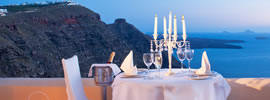
Click here to see our unique selection of luxury vacations throughout Latin America
- Luxury Travel Argentina
- Luxury Travel Antarctica
- Luxury Travel Bolivia
- Luxury Travel Brazil
- Luxury Travel Caribbean
- Luxury Travel Chile
- Luxury Travel Costa Rica
- Luxury Travel Ecuador
- Luxury Travel Galapagos
- Luxury Travel Guyana
- Luxury Travel Honduras
- Luxury Travel Iguassu Falls
- Ultra Luxury-Luxury Retreat Collection
- Luxury Travel Machu Picchu
- Luxury Travel Mexico
- Luxury Travel Panama
- Luxury Travel Patagonia
- Luxury Travel Peru
- Luxury Travel Peru & Brazil
- Luxury Travel Peru & Costa Rica
- Luxury Travel Peru & ecuador
- Luxury Travel Peru & Mexico

- Private Jet Antarctica Charter
- Private Jet Argentina Charters
- Private Jet Bolivia Charter
- Private Jet Bora Bora Charter
- Private Jet Brazil Charters
- Private Jet Caribbean Charter
- Private Jet Costa Rica Charters
- Private Jet Chile Charters
- Private Jet Ecuador Charters
- Private Jet Galapagos Charters
- Private Jet Guyana Charters
- Private Jet Honduras Charter
- Private Jet Mexico Charter
- Private Jet Panama Charter
- Private Jet Peru Charters
- Private Jet Surinam Charter
- Private Jet Tahiti Charter

- Bolivia Tours
Bolivia - Apolobamba Trek
La Paz - Lagunillas - Mil Curvas - Pelecucho Description: This trek will take you to the splendid Apolobamba mountain range, at the territory of the Kallawayas, the last ethnical trace of the landlords of Tiwanaku, whose language, the Pukina, is still spoken. Traversing the Apolobamba mountain range, between 4000 and 5000m in altitude, the western side of the trek will show permanent snows whilst to the east the deep valleys descend into the Amazon basin.

- What is included?
- Book this Tour
- Bolivia factsheet
Departure from the hotel in a private 4x4 vehicle where we shall pass along the mythical Titicaca Lake route before going across numerous villages of the altiplano. We shall be able to visit the chapels at the villages of Carabuco and Escoma, described as the Bolivian «Sixtines». Then, after a stop for lunch, several gorges and hairpin turns, we will reach the summit, to admire the Apolobamba mountain range and its imposing peak, the Akamani (5666m). At mid afternoon we reach the locality of Charazani, where we can enjoy its hot springs. After some additional hours in 4x4 and from one village to another, we arrive to the small town of Lagunillas. Lunch on our way before spending the night in the comfortable lodging at Lagunillas (showers, fire place ).
This is from where the altitude trek starts with passage by several gorges between 4500 and 5000m (at least two gorges per day). From 5 to 7 hours trekking per day. Good physical condition indispensable. After breakfast, departure from the lodge for a walk towards Curva (3780m). The village remains the most typical site of the region; with stone houses, local Indians in traditional garments. We shall visit the medicasters' hospital, where practitioners always heal using the plants of the region. A two hour's stroll take us to the site called Jatunpampa, where we shall have our lunch, accompanied by the murmur of the brook nearby, and by abundant fauna (llamas, viscachas etc). Our road continues with the ascent of two gorges; the Moyokaka (4500m) and the Tambillo (4700m) which we shall climb respectively in 2 and 3 hours. In the distance, we shall see the Royal Mountain Range. We descend to the valley where we shall set up our first camp (Incacancha 4100m).
After breakfast, we depart from our camp for an abrupt ascent of about 2 hours (Mil Curvas gorge- 4585m). We arrive to a small altitude lagoon, where the silence of the mountains nearby is incredible. We shall have lunch in the valley at the foot of gold mines, and at the beginning of the afternoon we shall be engaged with the second gorge of the day (Viscachani gorge, 4825m). The summit of the Huayna Sunchulli will slowly appear in front of us. After an hour's descent, we shall reach the gold mine «the Virgin of the Rosary» where we can find miners in their environment, and eventually buy some nuggets of the precious metal. Finally, a promenade at the end of the day by the «pueblo perdido» (lost town) near the mine where the Spaniards built their lodgings. Camp.
From here we climb along a steep hill to reach the Sunchulli gorge (4905m) in about 2 hours time. A small lagoon appears like a picture before us, at the foot of an imposing snow mountain. Once more, we discover gold miners. A slight descent, and it's time for lunch. Early in the afternoon, after a two hour trek which will lead us to the Koppe gorge (4930m) where we shall be delighted with the lunar landscapes of the valley of Azanjoce and a superb panorama of the Andes. Pauchi Cocho camp at 3700m is reached after a descent of 2 hours.
Today, three successive gorges await us; Pichuara 4370m, Quimza Cruz 4550m, and Pelechuco 4700 m. We descend to the valley of the Hilo Hilo River to start a nearly 5 hours ascent, at the end of which we shall attain the culminating point of the day (the Pelechuco gorge). We traverse across picturesque villages with small huts that have straw roofs and, if we are lucky, we shall perhaps see the flight of a condor. After a long descent towards Pelechuco (2 hours), now we can see the imposing Katantica. At 5560m the mountain dominates the valley wherein we penetrate. Arrival to Pelechuco at the end of the afternoon. We spend the night at a basic lodge.
Departure from Pelechuco for our return in private 4x4 to La Paz, passing by the National Park of Ulla-Ulla and the Cololo Lake (a 9 hrs journey). We shall appreciate the fauna and specially hundreds of vicunas, llamas and other camelids. Lunch on our way before arriving to La Paz.
Please Contact Us
- |

With Peru’s celebrated “Inca Trail” to Machu Picchu straining under the weight of trekkers (you need to book a starting slot several months in advance), savvy adventurers are searching for alternative Inca paths to explore. Bolivia offers several Inca trails, of which the route through the Cordillera Apolobamba is arguably the best and certainly one of the least trekked. High, wild, and remote, the Apolobamba trek offers breathtaking Andean wilderness, a glimpse into the heart of ancient cultures, and guaranteed sightings of rare wildlife including alpacas, vicuñas, and majestic condors.
The trail begins in the peaceful village of Curva, the heart of the ancient Kallawaya culture. The Kallawayas were the mystical healers and fortunetellers who treated Inca aristocracy, and their vibrant way of life survives today. The guide for the journey was Paulino, a local Kallawaya. We climbed a crest out of Curva and the glaciated Apolobamba range immediately came into view. We passed sacred sites where Kallawayas sacrifice llamas to ask for Pachamama’s blessing for harvests, work and health.
For two days we climbed toward Akhamani, the Kallawayas’ sacred mountain, its lower slopes carpeted with terraces and grazed by llamas, alpacas, and sheep. Ancient, stone-walled enclosures and thatched stone cottages for local herders dotted the slopes.
In Jatumpampa, we caught trout from a tiny stream, which we ate for supper in the cozy interior of a Quechua house. We climbed steeply over dark rocks to two high passes and, as is the custom, placed white stones on their summits to ask for good luck and strength.
Chased by low clouds drifting over the pass, we descended into a misty bleak wilderness. Dark, lichen-covered rocks towered above us in near-vertical cliff faces, some overlain by frozen waterfalls, until the landscape finally started to mellow. We crossed an area of open country and reached “Inka Kancha,” a site once used by the Incas to graze animals, and which still bears the ruins of corrals.
Next morning, ice made it difficult to unzip the tents, as we emerged into a bitterly cold, although crisp, dry dawn. We could barely believe the sight of Akhamani bathed in brilliant morning sunlight against the backdrop of a cloudless blue sky and nearly full moon.
Our journey took us over more high mountain passes with staggering vistas of the broad valleys and the cordillera’s snow-covered peaks beyond, past trout-filled lakes and occasional gold mines, and into pastoral scenes of shepherds tending flocks of sheep.
We arrived in Pelechuco almost before we could see it through the mist. Most Apolobamba treks end here, although the scenery becomes even grander further north toward the magnificent, glaciated summits of Presidente and Flor, and the Katantika Pass, which is marked by several turquoise lakes and some of the most breathtaking scenery in the Andes.
For More Info
You can trek the trail in either direction, although the trek is arguably better from south to north—Curva to Pelechuco. You can arrange Apolobamba treks with many La Paz tour agencies although it is cheaper to make arrangements yourself in either Curva (or its satellite village of Lagunillas) or Pelechuco. Guides cost Bs70 ($10) per day and packhorses Bs60 ($8.50) per day. You will also need to buy food and bring camping equipment.
Guides recommend a 5-day itinerary, although the first two days of the “standard” south to north trek are very short. Ask to compress the first two days into one and use the extra day to continue to the breathtaking Katantika Pass.
You can travel by bus from La Paz to the trailheads at Curva (10 hours) and Pelechuco (12 hours). Fares: $5-$6.
The trek stays mostly above 4,000 meters with several high passes reaching a maximum elevation of 5,100 meters. Make sure you acclimatize for several days before beginning the trek.
Tour Operator - Travel Agency

Activity: Tour Operator License of operation by Provincial Municipality of Huaraz - Permit Number: 2009-09774 License of operation by Regional Government of foreign trade and Tourism of Ancash Number: 105-2010-DIRCETUR RUC SUNAT (sole taxpayers Registry Number): 20408115087 Authorized by Huascaran National Park N° 42
Peruvian Mountains EIRL Trekking and Climbing Peru
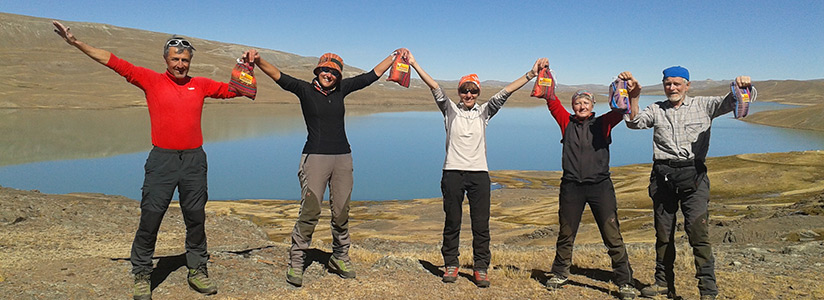
Cordillera Apolobamba Norte Trek + Titicaca Lake
Description.

Date & Price

2-FOR-1 GA TICKETS WITH OUTSIDE+
Don’t miss Thundercat, Fleet Foxes, and more at the Outside Festival.
GET TICKETS
BEST WEEK EVER
Try out unlimited access with 7 days of Outside+ for free.
Start Your Free Trial
Powered by Outside
Cordillera Apolobamba, Bolivia
See the andes the way cortez did–totally wild..
Heading out the door? Read this article on the new Outside+ app available now on iOS devices for members! >","name":"in-content-cta","type":"link"}}'>Download the app .
Pyrenees Traverse, France | Cape Wrath Trail, Scotland | Zillertal Alps, Austria | Tongariro Northern Circuit and Heaphy Track, New Zealand | Cordillera Apolobamba, Bolivia | Overland Track, Australia | Sarek National Park, Sweden | Rolwaling and Khumbu Valleys, Nepal | Polar Route, Greenland | Simien Mountains National Park, Ethiopia
South America’s highest nation is known as the “Tibet of the Andes” for its altiplano, a plateau where valley bottoms sit at 13,000 feet. Above that, mountains are so big and buried in snow and glaciers that you really could mistake them for the Himalayas. And the best place to see it all is western Bolivia’s pristine and barely known Cordillera Apolobamba. Hard against the Peruvian border, the region is home to Andean condors, herds of vicuñas (related to alpacas), endangered speckled bears, and the 65-mile Apolobamba trek, which runs from Curva north across Apolobamba National Park to Pelechuco. The weeklong high route crosses five passes between 15,400 and 16,728 feet.
Spend at least one night pre-trek in the small town of Charazani (Curva has no lodging). It’s the capital of the Kallawaya medicine men, who travel village to village dispensing herbs and magic to heal the sick (and sore; they’ll treat hikers for a small fee). If the medicine men are away, find rejuvenating hot springs a 10-minute walk from Charazani’s main square. From Curva, hike north in the shadow of 18,589-foot Akamani, sacred to the native Quechua and Aymara. Cross the mountains on ancient Inca-built trails and pass through quiet villages where burros are still the main form of transportation.
Life-list moment: Pitch your tent near mysterious Inca ruins at Incachani and take a bone-chilling shower in a nearby waterfall–where the ruins’ occupants probably bathed centuries ago. Next, in Sunchuli Valley, explore an abandoned gold mine worked by both the Spanish and the Inca. Inspired? Go exploring for the legendary city of El Dorado, which is purported to be near here.
Popular on Backpacker

Join Outside+ to get access to exclusive content, 1,000s of training plans, and more.
Healthy Living
- Clean Eating
- Vegetarian Times
- Yoga Journal
- Fly Fishing Film Tour
- National Park Trips
- Warren Miller
- Fastest Known Time
- Trail Runner
- Women's Running
- Bicycle Retailer & Industry News
- FinisherPix
- Outside Events Cycling Series
- Outside Shop
© 2024 Outside Interactive, Inc
- Call Us: +51 43 423733
- Departures 2024
Cordillera Apolobamba Norte Trek + Titicaca Lake

Huancaya at 3554m. is located in Lima region province of Yauyos, district of Huancaya it is a natural refuge. Huancaya has spectacular high Andean landscapes with beautiful lagoons of crystalline waters, with abundant flora and fauna and circuits of Inca trail caught in the time that invites you to discover them. The Nor Yauyos-Cochas Landscape Reserve offers the possibility to see landscapes surrounded by nature, rivers, many waterfalls.
Cordillera Apolobamba is a mountain range of Bolivian and Peruvian Andes. This hike start with a visit to the highest lake in the world Titicaca Lake at 3,800m. Copacabana, Sol Islands, interesting and pleasant place for a good start of the trek then transfer to Pelechuco village start of our hike. Cordillera Apolobamba Norte (little known) limits between Bolivia 70% and Peru 30% a remote circuit in the Bolivian Andes, a circuit with fields to over 4,400m, surprising and stunning colorful lagoons views, high mountains and temperatures very cold and one of the most beautiful and wild areas of Bolivia. During the trekking in the Cordillera Apolobamba North Let's see the next Mountains / nevado Soral O. 5,641, Chaupi Orco 6,044m. Flor de Roca 5,808m. Palomani Grande 5,768m, Katantica and lagoon Soral. Suches Lake, Laguna Chocullo, Laguna Iceberg and others.
Trekking: Cordillera Apolobamba Norte Trek.
Altitude: over 4,500m
Duration: 17 Days / 16 Nights.
Season: May to Octuber
Service: Private
TERMS AND CONDITIONS
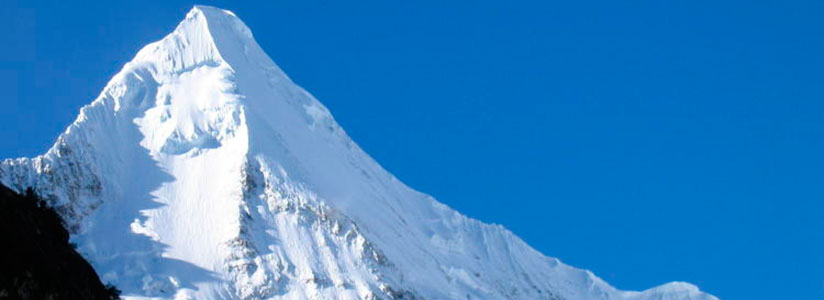
School Travel 2024
Student group adventures in peru.
Studens Trekking to Santa Cruz Circuit Student Group Tour Llanganuco, Pastorury, Chavin
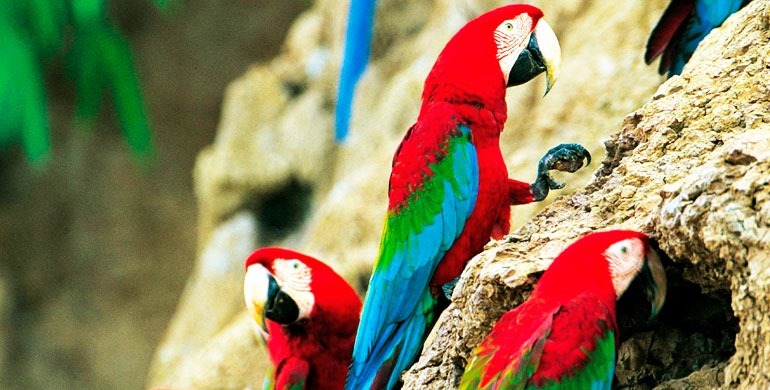
Manu Expedition 2024
2 packages available.
Manu Biosphere Reserve Manu Expedition

Cuzco trek 2024
Machu picchu experience.
Machu Picchu-Tour Cuzco 2 days Inca Trail-Machu Picchu 4 days Rainbow Mountain Cuzco Tours Machu Picchu Rainbow Mountain Cuzco -->
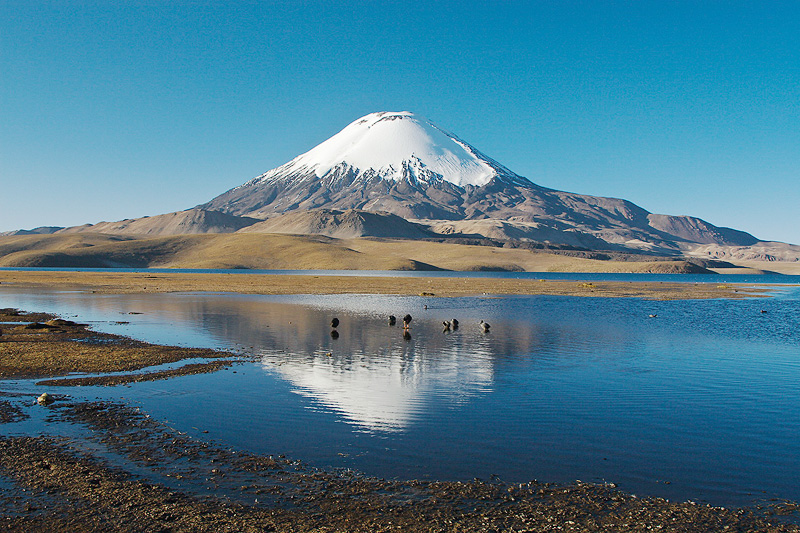
Bolivia Mountains
Join us expeditions 2024.
Sajama Volcano Climbing Corillera Real Treking Bolivia Pequeño ALpamayo Climb Bolivia 4 days

Argentina Treks & Climbs
Aconcagua expeditions 2024-2025.
Aconcagua Climbing Acongagua Trek-Trek to Plaza de de Mulas

Chile Expeditions 2024
Torres del paine & ojos del salado.
Torres del Paine W–Trek-Patagonia Ojos del Salado Volcano Climb Torres del Pain Circuit O - Full Trekking Chile
Photo Gallery


Apolobamba II
Curva – Pelechuco (6 days).
The Apolobamba mountain range is a seldom-traveled trail despite its natural beauty combining high plateau, valleys and snowcapped mountains. It is a mystical region, where world-famous native healers known as kallawayas live. It is a magical place of perpetual snowcapped mountains and few native inhabitants.
Day 1.- La Paz – Charazani. Departure early from La Paz on a vehicle. We cross the high plateau along the edge of Lake Titicaca. In the port of Escoma we go into the Apolobamba mountain range. We are able to see small mountainous massifs before we descend to the village of Charazani, located already in a valley. Later, we continue the journey toward the native village of Curva.
Day 2.- Charazani – Jutumpampa. We leave early to ascend between ravines and Andean plantations. A spectacular view of stunning Akamani Mount, sacred mountain for the kallawayas, could be seen. To the sides, a succession of splendid snowcapped mountains. The trail toward Jatunpampa continues by a deep valley.
Day 3.- Jutumpampa – Incacancha. We leave from Jatunpampa following a path that will lead us up to the foot of the glacier. After enjoying lunch, we are ready to go down to the ruins of Incacancha. We install our camp near the waterfalls.
Day 4.- Incacancha – Sunchulli. We leave from the waterfalls taking the path that starts with a gentle but constant ascent. Beside the path runs a small ravine that goes down to the valley of Sunchilli, where we will see the famous pre-Columbian mines. Camp at the top of the mining camp and near the Knife Peak I.
Day 5.- Sunchulli – Palca. This day we cross the pass Sunchulli and go down through the valley of Piedra Grande, Ilo Ilo, and end at Palca where we set our camp.
Day 6.- Palca – Pelechuco. Last day of descent to Pelechuco. Relaxed day. There is more oxygen in the air due to the presence of a humid valley with wild flowers along the path. Here, the pre-Columbian trail appears calling to the mind a large alley that leads us to the village of Pelechuco. Accommodation. Day 7.- We depart from Pelechuco – La Paz on a vehicle, crossing the high plateau regions of Ulla Ulla and Apolobamba.
Scheduled Group Dates
We are able to accommodate both trekking and climbing expeditions on dates that suit you, as long as our guides are available. Most trekking tours are classified as medium difficulty and require a certain level of fitness for all participants. Additionally, for all climbing expeditions, we recommend good acclimatization. We have a number of fixed travel dates for our most popular climbing routes for those who want to join other climbers. The service is similar to our private trips, but since you will be part of a group, the cost may be a bit lower. Group sizes are a minimum of 2 and a maximum of 10 (for safety reasons, one guide to two clients). If you’re interested in joining one of our group outings, please contact us and specify which program you’re interested in. Please note that if there is only one person on a scheduled date, we will continue the itinerary as planned. We will also keep you informed of other similar expeditions in case you prefer to join a different group.

- +591 77580433
- [email protected]
Copyright © 2022 Bolivian Mountain Guides. All rights reserved.
¿Olvidaste tu contraseña?
Lost your password? Please enter your email address. You will receive mail with link to set new password.
Atrás para iniciar sesión
Thanks for getting in touch with Bolivian Mountain Guides!
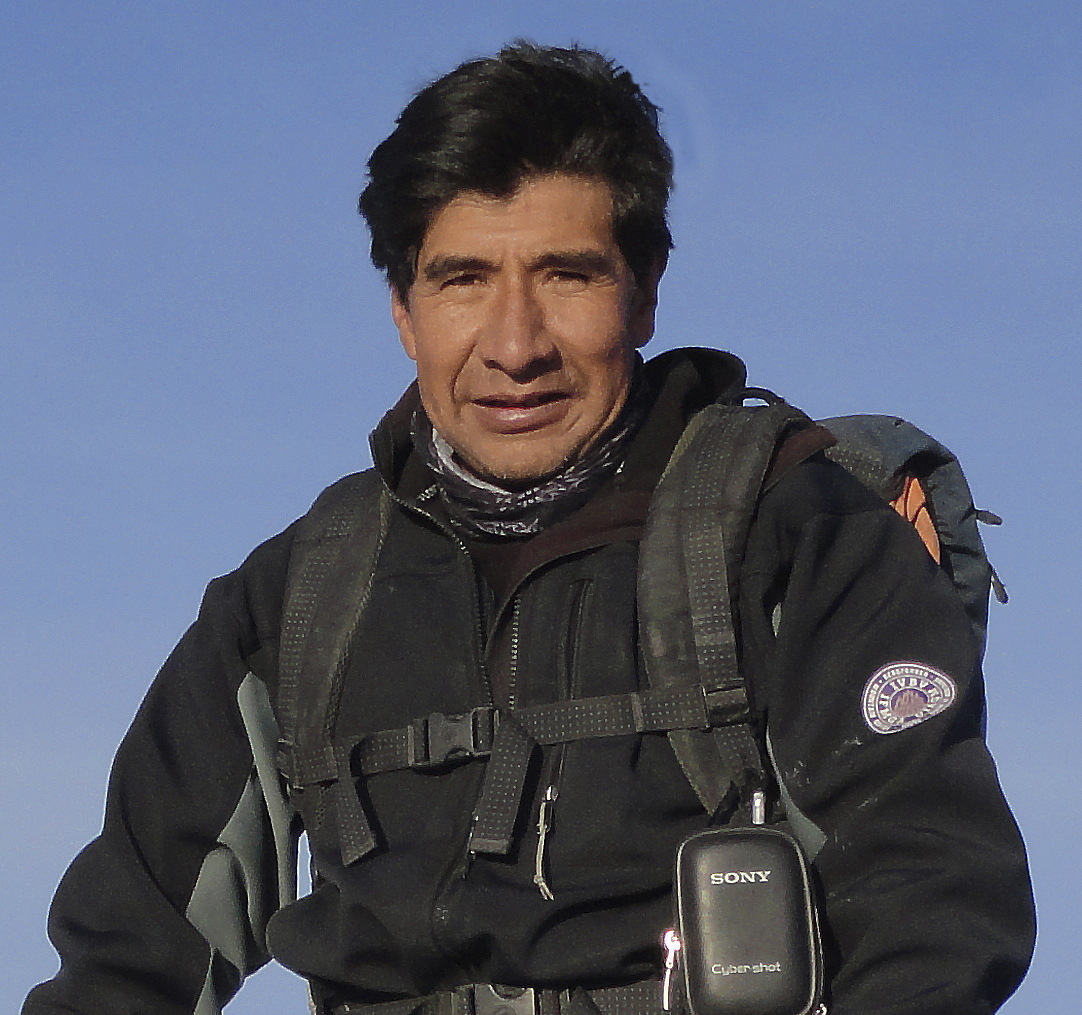
We'll try our best to help you organize your next travel in Bolivia.

The Apolobamba Cordillera
This relatively unknown region of Bolivia is home to countless natural wonders. It is on these " high Andean plateaus " bristling with snow-covered peaks that an ethnic group, as mysterious as it is isolated, has chosen to settle: the Kallawayas .
Sumptuous landscapes will accompany you in these infinite spaces, at the same time wild, remote, with an insolent beauty. This excursion is proposed to you in the form of trekking, the best way to get acquainted with these lands populated by an enigmatic ethnic group.

You are using an outdated browser. Please upgrade your browser or activate Google Chrome Frame to improve your experience.

- Select Language English French
- Destinations
- South America Tours Calendar
- South America Tour Finder
- Late Availability
- Inspirational Journeys
- Argentina Travel Highlights
- Bolivia Travel Highlights
- Chile Travel Highlights
- Colombia Travel Highlights
- Ecuador Travel Highlights
- Galapagos Islands Guide
- Patagonia Travel Highlights
- Peru Travel Highlights
- Peru Trekking Highlights
- Peru Amazon Rainforest
- Useful Links & Resources
- Books & Guides
- Health & Safety Travel Advice
- Meet the Team
- Our Partners in South America
- Andean Trails Background
- Community Projects
- Paramo Clothing Discount
- Testimonials
- South America Flight Advice
- Make a Payment
- Booking Conditions
- How to Book with Us
- Travel Insurance
- Why Book with Us?
Best hikes and trails in Bolivia

- Bolivia
- Climb
- Travel Advice
- Travel Planning
- Trekking
- Walking Tours
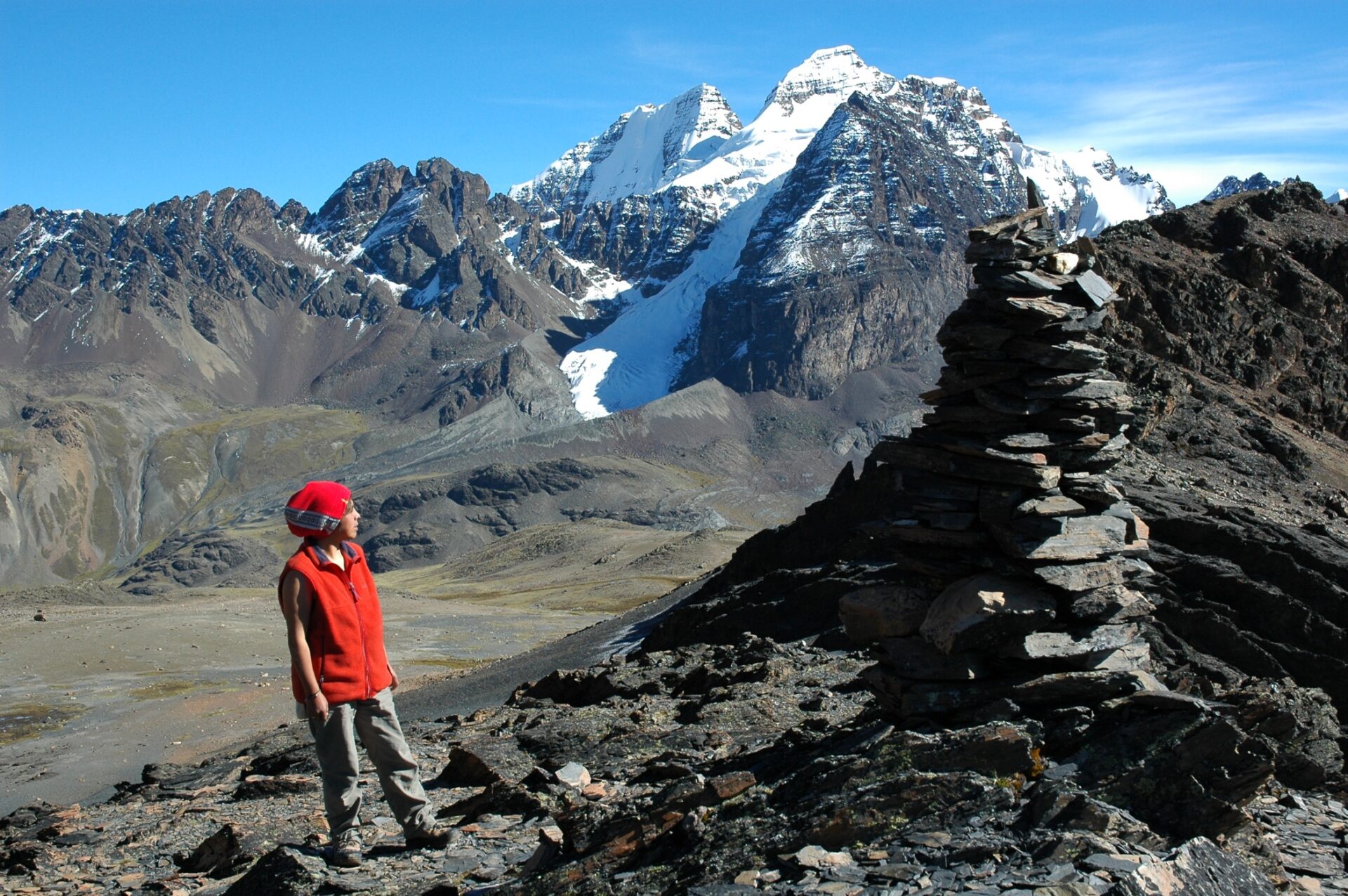
The hills and mountains of Bolivia are much less known than the Cordilleras of southern Patagonia or the high Andes of neighbouring Peru.
The Bolivian Andes are beautiful and majestic and offer a wonderful array of multi-day treks as well as some superb day walks, trekking peaks and some technical mountaineering.
We sum up just a few of our favourite multi-day treks and walks here, and suggest you get in touch for additional ideas and further information.

Volcanoes in Bolivia
The Cordillera Real traverse is one of the best treks in Bolivia. This is a superb mountain getaway experience with very few trekkers in the middle section in particular. The whole route takes 10 to 12 days from Sorata to Huayna Potosi, but it can be divided up into shorter treks.

Cordillera Real
For a shorter, more accessible and less strenuous version the Condoriri to Huayna Potosi trek is superb. Lake Chiar Kota at the base of Condoriri is one of most beautiful camping spots in Bolivia.

There several sections of Inca Trail in Bolivia. Of the Inca Trails one of the best routes is the Takesi trek. There are other routes in the area but some of the forests are being cut down by coca growers, so always check first.
Another lovely Inca Trail is the 2 day trek in Sama national park above Tarija, a trek that takes you from the Tazjara lakes down to Concepcion valley. This is a very little known part of Bolivia and you have the added bonus of being able to enjoy the local wine and Singani in the bodegas afterwards.
Toro Toro is spectacular and most options there are shorter walks rather than treks.

Sajama national park is one of the most beautiful in Bolivia There are several day walks and a multi-day trek with superb high altitude camping, right on the Bolivia / Chile border. There are warming hot springs, geysers and the option of some non-techincal 6,000m climbs such as Parinacota and Acotango. This is a remote high platuea with volcanoes dotting the landscape, small village and large flocks of llama and alpaca.

Sajama hot springs
The walking on Isla de Sol, from north to south, gives beautiful panoramic views of Lake Titicaca.

Another great hike is the climb up Tunupa volcano, with the most stunning views over the Salar de Uyuni and close up views of the red rainbow colours on the volcano itself.

Tunupa Volcano
The remote Apolobamba range offers very remote fabulous high altitude trekking opportunities. There are routes from 4 or so days up to 12 or so days, depending on the chosen route. Very few trekkers go this far off the beaten track and there is little tourist infrastructure. Some of the old trails have been turned into roads by miners In recent years as gold mining has been booming and a lot of old mines reopened by cooperatives.
Thanks to James of Magical Andes for his help with putting together this blog.
Leave a Reply Cancel reply
Your email address will not be published. Required fields are marked *
You may use these HTML tags and attributes: <a href="" title=""> <abbr title=""> <acronym title=""> <b> <blockquote cite=""> <cite> <code> <del datetime=""> <em> <i> <q cite=""> <s> <strike> <strong>
Save my name, email, and website in this browser for the next time I comment.
Suggested Trips
Bolivia torotoro national park tours.

What's a group trip?
Join a small group of like-minded travellers on a guided trip.

What's a tailor made trip?
We put together a bespoke tour to fit your requirements.

What's part of a tailor made trip?
Include this guided group tour within your tailor-made tour.
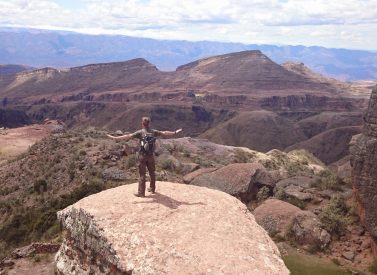
Prices From $554 / £450 per person
Dates: From January 2024 to December 2024
Duration: 3
Comfort Level:
Capacity: 16 people
Discover More Enquire about booking
Climb Sajama & Parinacota, Bolivia
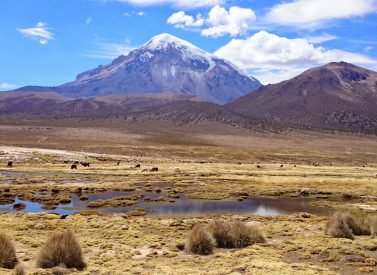
Prices From $4,291 / £3,489 per person
Duration: 17
Condoriri Trek & Hike, huayna potosi
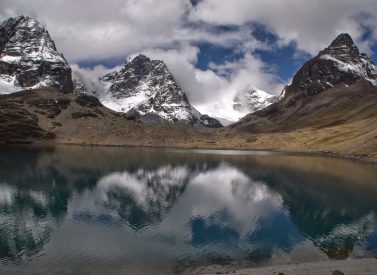
Prices From $1,211 / £985 per person
Duration: 4
Condoriri Trek & Huayna Potosi Climb
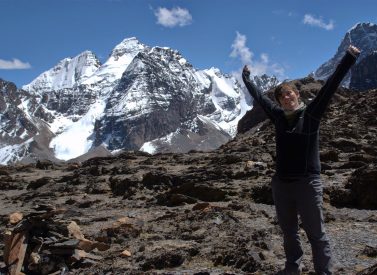
Prices From $1,981 / £1,611 per person
Duration: 6
Sajama National Park Trek & Tour, Bolivia
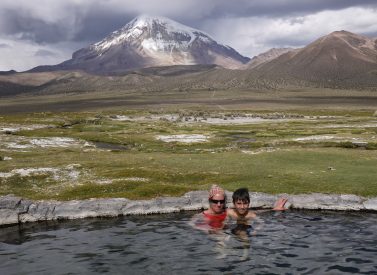
Prices From $1,488 / £1,210 per person
Quick Request New
- Latest Twitter Follow Us on Twitter
- Facebook Like Us on Facebook
- Pinterest Follow Us on Pinterest
Ecuador’s best lodge-to-lodge hiking tour
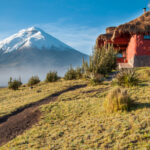
Our lodge-to-lodge hiking tour offers the best trekking in Ecuador in comfort. Ecuador is one of the best Andean countries for trekking and day walks. On this lodge-to-lodge hiking tour, you experience fabulous expansive mountain vistas and volcanoes wherever you look. Enjoy views over deeply carved valleys, vast plains and a picturesque patchwork of fields. You’ll also enjoy diverse wildlife and flora, rich cultures, and interactions with friendly local people. The tour takes you through three of Ecuador’s most beautiful mountain regions: Cotopaxi, Quilotoa and Chimborazo. Full details of our Lodge-to-Lodge 13-day Trekking Tour, Ecuador. Lodges and Guesthouses Used …
Read More
- Comments This field is for validation purposes and should be left unchanged.
Sign up here to receive the latest news and info from Andean Trails

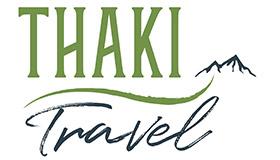
- +33 9 77 21 51 60 Call in Bolivia at the price of a call in France
- +591 2 215 60 82 Call in Bolivia at the price of an international call
- [email protected]
- thaki-bolivia
North of the Cordillera Real, lies the Cordillera Apolobamba , northeast of Lake Titicaca, it is part of the Eastern Cordillera that extends along a northwest / southeast axis and the Cordillera further south. Difficult access, is accessed by a bad dirt track in ten hours from La Paz. You also enter the fascinating world of Kallawayas , Andean community who practices traditional medicine. These are itinerant doctors who gave the name to this population, Kallawaya meaning in Quechua “ the one who carries plants on his back “.
Until today, this mountain was covered by trekkers on its eastern side. The trek was far from glaciers and mostly in the mists from the tropical part.
Thaki offers a new alternative along this beautiful and wild Apolobamba Cordillera by its western side, keeping as close to the glaciers.
Indeed, the Thaki Team had gone to explore the hidden treasures of this beautiful Cordillera during an expedition conducted in May 2013. The essence of this project was to share our passion between friends keen of mountain, Bolivian guides and members of the Thaki team. The entire expedition was scheduled over 12 days. The idea was to open a new route from the south to the north by the altiplano slope, keeping as close to the glaciers. It was expected to climb 5 peaks between 5,700 and 6,000 m. A film was made subsequently highlighting those Bolivian men living their passion in a country where the mountains are sacred places.
With this expedition, we offer today to discover this unique trek in Cordillera Apolobamba.
Having spent the past pretty stone houses in the first valley and its welcoming people, you will go on a wild trek and engaged at will, sometimes out of trails. You will sway between the high desert plateaus and valleys often collected at the foot of majestic glaciers and home to many different blue lagoons. The snow-capped mountains as Akamani (5.700m), the Ullakaya (5.810m), the Anta Kajwa (5.925m) or the Huanacuni (5.795m), punctuate your days all along the trip. These unfrequented paths allow you to watch the llamas and alpacas, but also other animals like wild vicuna or the “venados” Andean deer species.
Your path will then end in a beautiful valley which ends its run at the foot of a huge ice mass, forming an impenetrable barrier of snowy peaks. A walk along a pretty stream, winding between the rocks and two beautiful lagoons of green glacier will take you to your final step of this adventure, glacier Chaupi Orco , which rises to 6.044m.
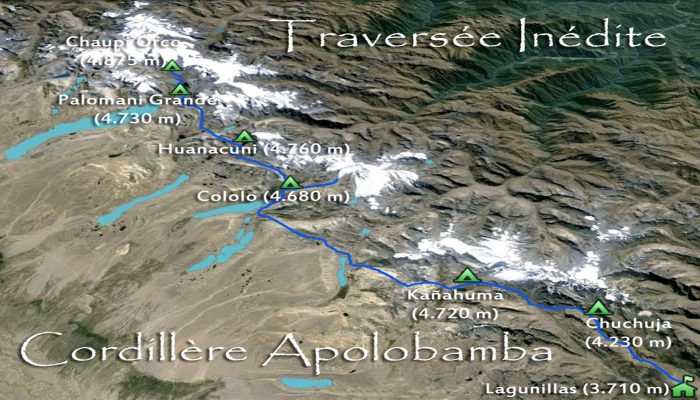
Preparing a trip to Bolivia ?
We'd love to help , autres points d'interets à apolobamba.
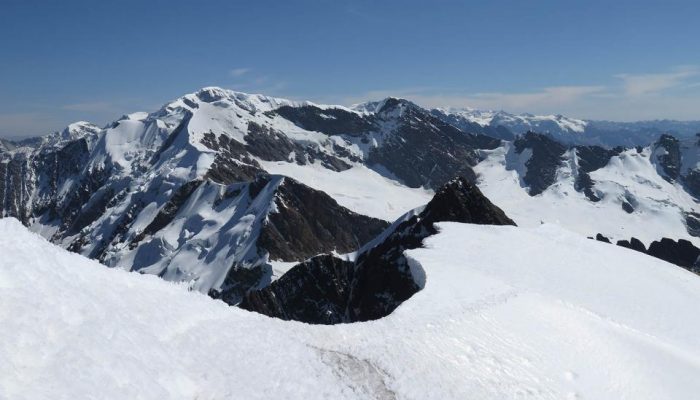
Ullakaya and Condorini
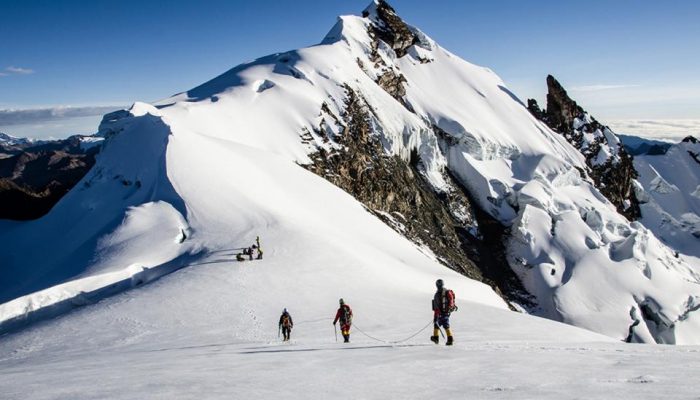

IMAGES
VIDEO
COMMENTS
This trek begins in the northernmost town of Pelechuco near the Peruvian border in the northernmost remote corner of the Apolobamba range and heads south through one of the most impressive ranges of the Bolivian Andes. Surrounded by majestic glacier-covered peaks and deep Andean valleys you will trek through the home of condors and the Kallawaya spiritual healers. A truly impressive region ...
The Apolobamba mountain range is a path that is little-traveled despite its natural beauty, which combines a high plateau, valleys, and snowy mountains. It is a mystical region where world-renowned native healers known as Kallawayas live. It is a magical place of perpetual snow mountains and few native inhabitants.
Bolivian Journeys. Our trek in the Apolobamba will start in the village of Curva at 3,900m and finish in the very remote village of Pelechuco at 3,600m. On the way we cross several high passes and the scenery all along the way is superb. The Apolobamba trail is the most spectacular trek in the Bolivian Andes.
The Trekking in the Cordillera Apolobamba Tour is an exciting opportunity to call the Andes home for 9 days, exploring all that makes this mountain range so special. If you like stunning scenery, Bolivian culture and great trekking, then this is the trekking tour for you! The Trekking in the Cordillera Apolobamba Tour is all about the elevation.
There are a whole host of alternatives in the Apolobamba range, most of which you will have completely to yourself (apart from the farmers) - a very remote part of the Bolivian Andes. ... High altitude trek close to Illampu. 5,030m 4 days from $600. Transcordillera. Cover the entire length of the Cordillera Real. 5,200m 12 days from ...
Bolivia's Altiplano - 500×170 km (310×105 mi) at av. height of 4,000 m (13,000 ft) The remote Apolobamba range where the ancient cultures of medicine men still thrive. Native Aymara and Quechua people that are part of the intricate social fabric of Bolivia. Visit Inca ruins that are the roots of the most expansive empire in South America.
This trek will take you to the splendid Apolobamba mountain range, at the territory of the Kallawayas, the last ethnical trace of the landlords of Tiwanaku, whose language, the Pukina, is still spoken. Traversing the Apolobamba mountain range, between 4000 and 5000m in altitude, the western side of the trek will show permanent snows whilst to the east the deep valleys descend into the Amazon ...
Bolivia offers several Inca trails, of which the route through the Cordillera Apolobamba is arguably the best and certainly one of the least trekked. High, wild, and remote, the Apolobamba trek offers breathtaking Andean wilderness, a glimpse into the heart of ancient cultures, and guaranteed sightings of rare wildlife including alpacas ...
Cordillera Apolobamba is a mountain range of the Bolivian and Peruvian Andes. This hike starts with the visit to the highest lake in the world Lake Titicaca 3,800m. Call us: +51 43 423733 | Volunteer Social Project Partner With Us Departures 2024 Blog Recommendations
Day 1: Travel from La Paz to Qutapampa and trek to Kaluyo. Get an early start this morning in order to make the most of your day in the Apolobamba National Park. Pass through the city of El Alto and along the coast of Lake Titicaca as you head north and begin the climb into the Cordillera. Your destination today is the tiny village of Qutapampa ...
Apolobamba Norte. Circuit of the lakes (8days). This is a new route between the border of Peru (30%) and Bolivia (70%). It's a beautiful trekking routes through areas with gaps of different colors and especially the wonderful landscapes of snow-capped mountains.
And the best place to see it all is western Bolivia's pristine and barely known Cordillera Apolobamba. Hard against the Peruvian border, the region is home to Andean condors, herds of vicuñas (related to alpacas), endangered speckled bears, and the 65-mile Apolobamba trek, which runs from Curva north across Apolobamba National Park to Pelechuco.
An account of the Trans-Apolobamba trek, Bolivia. 28 February 2014. Rosemary Morlin has kindly shared her experience of trekking the little known, off-the-beaten-track Trans-Apolobamba trek in Bolivia. We eventually reached Pelechuco in the late afternoon despite interminable traffic jams in El Alto and frequent stops at army and police ...
This trek begins in the northernmost town of Pelechuco near the Peruvian border in the northernmost remote corner of the Apolobamba range and heads south through one of the most impressive ranges of the Bolivian Andes. ... An early departure from La Paz begins the journey into one of the most impressive and least visited regions of Bolivia ...
Trekking: Cordillera Apolobamba Norte Trek. Altitude: over 4,500m. Duration: 17 Days / 16 Nights. Season: May to Octuber. Service: Private. Book Now. Cordillera Apolobamba is a mountain range of the Bolivian and Peruvian Andes. This hike starts with the visit to the highest lake in the world Lake Titicaca 3,800m.
A characteristic Apolobamba landscape. ... Nevertheless, this is not a very popular trek. In 2001, just 350 tourists were recorded in Curva, the small village at the end of the trek. ... Sagarnaga Street #233, Office 3, La Paz - Bolivia (591-2) 231-6760 (591) 77544481 [email protected]. Inca Land Tours Bolivia 2019. Terms & Conditions ...
Trekking in Bolivia gets you close to snow-capped mountains in the isolated Cordillera Real or Apolobamba. Walk the tough Apolobamba Circuit and follow some of the best-preserved Inca trails in South America. Or hike the shorter and more accessible but no less stunning 4-day Hichukhota to Condoriri trek.
Trek Ajuani - Huayna Potosi (7 days) Trek Chachacomani - Huayna Potosí (7 days) Trek Chojña Khota - Huayna Potosí (10 days) Trek Transcordillera (14 days) Trek Apolobamba (Pelechuco - Charazani) (6 days) Trek Apolobamba (Curva - Pelechuco) (7 days) Trek Apolobamba Norte - Circuito de los lagos (8 dias) Tours. Tihuanacu (Full Day)
The Apolobamba Cordillera. This relatively unknown region of Bolivia is home to countless natural wonders. It is on these "high Andean plateaus" bristling with snow-covered peaks that an ethnic group, as mysterious as it is isolated, has chosen to settle: the Kallawayas.Sumptuous landscapes will accompany you in these infinite spaces, at the same time wild, remote, with an insolent beauty.
The remote Apolobamba range offers very remote fabulous high altitude trekking opportunities. There are routes from 4 or so days up to 12 or so days, depending on the chosen route. ... A spectacular, fully-guided 4-day Hichukhota to Condoriri Bolivia high mountain trek. Condoriri is a striking mountain to trek below - its three highest peaks ...
Continue on a guided trek through some of the most beautiful villages in the Bolivian Andes, then head to Apolobamba National Park in the Amazon rainforest for canoeing, hiking, and birdwatching. You'll have a free day back in La Paz to shop, sightsee, and enjoy Bolivian street food before the trip ends.
North of the Cordillera Real, lies the Cordillera Apolobamba, northeast of Lake Titicaca, it is part of the Eastern Cordillera that extends along a northwest / southeast axis. ... +33 9 77 21 51 60 Call in Bolivia at the price of a call in France ... With this expedition, we offer today to discover this unique trek in Cordillera Apolobamba.
Apolobamba is located in the eastern borderland of Peru and Bolivia. On the Bolivian side, the mountain range is situated in the La Paz Department and on the Peruvian side it lies in the Puno Region. It stretches across a distance of 50 km (31 mi) from east to west and 30 km (19 mi) from north to south. Curva, the main locality of the Kallawaya ...